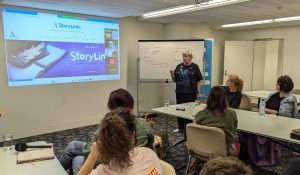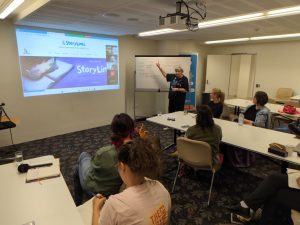
Writing Reviews with Mia Macrossan
StoryLinks Managing Editor, esteemed children’s book reviewer and former CBCA judge Mia Macrossan presented an enlightening session on writing reviews at the Write Links meeting on 29th June. Here are the details, based on her notes.
Who is the audience of book reviews?
Children’s books are written for children, but the buyers are often the adults, so the book has to appeal to both adults and children. A reviewer is usually not writing for children. They are writing for adults: the publishers, authors, teachers, teacher librarians, parents and academics.
- Megan Daley writes reviews for parents.
- Magpies is for teachers and teacher librarians.
- Your Kids Next Read provides reviews for parents.
- Newspapers target people who enjoy reading.
- StoryLinks publishes reviews for teachers, parents and specialists.

Who writes reviews?
Anyone, from writers to critics.
No writer ever writes a bad book review. They have a relationship with a publisher to establish and are writing for other writers.
What are the benefits for writers?
Reviews are a powerful way to establish an online presence, and also to develop your writing craft. When you are reading a book for pleasure, you are reading it for enjoyment. When you are reading it for review, you are looking at structure, character, the writing, which is helpful in your own writing journey.
What are the purpose of reviews?
To get news of the book out there, to support writers. To advise teachers and teacher librarians. The book might be the best thing since sliced bread, or the bible, or The Lord of the Rings, or Fifty Shades of Grey, but if no one’s heard of it, it won’t get anywhere.
Also, authors and publishers like to see the response to the book. StoryLinks has been quoted by authors and publishers on their site, so it has a reputation as a dependable, reputable site.
What is a review?
A book review is an honest reaction to a book that generally analyses literary elements and literary devices.
Literary elements include the plot, narrator, POV, characters, conflict, setting, language and theme. These are the who, what, where, when, why, and how of a story. If the story lacks an answer to one of these questions, it’s an incomplete story.
The literary devices include symbolism, similes, metaphors, tone, mood and imagery. A story’s mood is the emotional response the author is targeting. The imagery is the descriptive word choice.
Writing a review
Mia has always encouraged reviewers to develop their own voice. But for StoryLinks’ beginning reviewers, she normally recommends this framework:
• Opening statement
• Plot summary
• Analysis
• Illustrations
• Conclusions
Opening statement. Give a flavour of the book and the writer, and mention if it is part of a series. StoryLinks reviews typically mention who the author is, their background, any awards, if they’ve changed category.
Examples:
- The Garden of Broken Things. By Freya Blackwood. Reviewed by Lara Cain Gray. ‘The Garden of Broken Things is the latest offering from lauded author and illustrator Freya Blackwood. As may be expected of an accomplished creator, it’s a beautifully constructed journey in which the pictures and words carry equal weight in building the narrative.’
- The Dragon’s Treasure and The Vanishing. By Mark Greenwood. Reviewed by Sandy Driessens. ‘On a summer morning in 1931, four children on a remote beach in Western Australia, discovered ancient coins buried, like treasure in the sand. It ignited a treasure hunt that uncovered silver coins, hidden chests and a mysterious circle of stones. Was this treasure from the Dutch trading ship, The Gilt Dragon dashed on a reef in 1656? If it was, what happened to her crew … perhaps the unidentified skeleton was a clue?’
- The Kindness Project. By Deborah Abela. Reviewed by Helen Gearing. ‘Deborah Abela has written over 30 books for children, including the bestselling Max Remy series and the CBCA Notable The Book of Wondrous Possibilities. Abela is also a Writer Ambassador for Room to Read, an international organisation working to end illiteracy and gender inequality. Her latest middle-grade novel, The Kindness Project, is her first written in verse.’
Plot summary. Keep it short. No spoilers. Give the age of the main protagonist, the setting and time situation. Reviewers typically have the most difficulty with this section. They might say, ‘Here is this book by Mary Smith, the third book in the series.’ Then they include three paragraphs of plot, followed by ‘I thought this book was wonderful.’ You need more.
Remember, there are usually two things happening in the story: the main character’s inner conflict, and the external conflict. Mary Jane might be shy, or she might have eczema or a disability, which cause her to not make friends or to fight with her siblings or not do well at school. And at the same time, there’s an external issue, such as her mother is kidnapped and Mary must overcome her fears to save her.
When you’re reading the story, ask: Do the internal and external stories work? Do I engage with this character? Is this believable? Are the character’s issues resolved too easily at the end? Was it a satisfying read? Did I read it in one sitting?
Examples:
- Always Anthony. By Terri Libenson. Reviewed by Mia Macrossan. ‘This latest story is again told from the alternating POVs, and it’s about popular Anthony (TPFW)* and timid Leah as they grapple with a bullying incident at school. Anthony and Leah meet when she becomes his writing tutor. Gradually they get to know one another and a friendship develops. Leah’s passions are food, writing and chemistry while Anthony is keen on science, sport and a girl in his class, Nikki.
One day they witness Anthony’s teammates bullying a sixth grader. What happens next could cement their new friendship or blow it up forever.’ - When there is no plot. Be True to You! Written by Maggie Hutchings and illustrated by Hayley Wells. Reviewed by Margarite Igras. ‘The gentle voice of the story speaks directly to the child with some positive lessons in self-worth and resilience. Just like there are many different songs, there are also many different people. Some see a princess in the mirror but in their heart, they know they are a king. ‘And if someone doesn’t like it, if they say, ‘This cannot be!’ Sing a little louder… ‘This is really ME!’’
- Books that are difficult to summarise. How to Measure the Ocean. By Inda Ahmad Zahri. Review by Zewlan Moor. ‘Children explore volume though water play, and counting and categorising through sorting their beloved collections, every day. This book can be read at many levels in the present, and revisited over time, as a child’s conceptual framework expands.’
- Ultra Violet 1: Down to Business. By Cristy Burne. Reviewed by Annaleise Byrd. ‘The story kicks off when our three heroes (a science-loving kid called Violet Butt, her conspiracy theorist friend Izzy, and a talking hermit crab called Leonardo da Pinchi) set out to unblock the school toilet on the day of the interschool bean-eating competition. Of course, their plan quickly goes down the toilet, and stinky shenanigans ensue.’
Analysis. Discuss characters, themes (e.g. parental splits, mental illness), language, writing style, mood, tone, literary elements and devices. You could compare to the author’s other works. Teachers are particularly looking for themes, to connect to their curriculum. The tone and the mood: Is this a humorous book? A depressing book? The writing style: Do they use short sentences, or long sentences? Does it flow well?
Examples:
- Deep is the Fen. By Lili Wilkinson. Reviewed by Tehani Croft. ‘While Deep is the Fen works quite well as a generic young adult dark fantasy, I kept waiting for the thematic richness of the previous book to appear, which unfortunately did not eventuate.’
- A Teaspoon of Light. By Peter O’Connor & Nisaluk Chantanakom. Reviewed by Sandhya Parappukkaran. ‘O’Connor’s text shines with evocative language and thought-provoking similes. Chantanakom’s artwork, which combines pencil, watercolour and digital edits, creates an amazing play of light and shadows on every spread, culminating in the most wonderful glow as the story reaches a satisfying end. As in all good picture books, the end papers give clues to the story within. Flip between front and back endpapers and see a cloudy mist of memories strengthen into more reassuring and solid recollections.’
- Ultra Violet 1: Down to Business. By Cristy Burne. Reviewed by Annaleise Byrd. ‘The story also incorporates an impressive amount of science, with mentions of dichotomous keys, iterative prototyping and the fact that 110% is not a valid percentage. There’s also some clever wordplay, amusing asides in the form of ‘artist notes’, an alien invasion to dramatically increase the stakes, a (crabby) pinch of romance, and themes of perseverance and sticking by your friends. Burne even squeezes in some subtle social commentary via the ‘absent parents’ trope being satisfied by Violet’s parents being so smartphone-obsessed they readily agree to let her buy chemicals online and explode their fridge.’
Illustrations. If there are illustrations, you could comment on illustrator and the work: the relationship between the art and text, the use of colour, the placement/arrangement of text and pics, the medium used, the tone, style, and graphics.
Conclusions. Mention the best audience, for example, children’s age groups or the school library, and the final takeaways.
Examples:
- By Suzy Zail. Reviewed by Mia Macrossan. ‘Perennial themes of identity, secrecy, death and dying, friendship, family and teenage love are expertly interwoven in this long, detailed story that will appeal to readers 14 years plus. Suzy says of this story: it’s the truest thing I’ve ever written and very timely. This truth and timelessness is what gives this story its resonance today. The publisher has provided many resources for those teachers considering using it as a class text including Author letter for teachers and Teacher Notes.’
- The Fortune Maker. By Catherine Norton. Reviewed by Mia Macrossan. ‘Serious themes of grief and loss, gender roles, power and resilience underpin this adventure but never overburden this exhilarating roller coaster read. The writing is assured, rich in historical detail, and enlivened by delightful insights into character. Mrs Wray telling Maud how her dad died: ‘They said it was a live elephant,’ she began, looking surprised to find herself uttering such a sentence. p21, or Maud ‘enjoying the noise her marching boots made on the stairs.’ p102.
I inhaled this book in one sitting and I think many others will do the same. This engrossing novel is perfect for Reader’s Cup and any school library. Its high production values indicate the publishers think they have a keeper and I agree with them.’ - Skye Blackburn-Lang: Eating Bugs for the Planet. By Dianne Wolfer. Reviewed by Sophia Evans. ‘Skye’s work to educate everyone on entomophagy (eating insects) is still a new concept for most Australians but ground-breaking within the food industry. There are full page colour photographs and illustrations throughout, as well as a selection of recipes at the back of the book.
This book will appeal to 10–13-year-olds, or those who are interested in bugs or cooking. I’m not 100% on board with eating something that has more than four legs; I’ve only ever eaten an insect by accident! But who knows, I might just try a Choc Chip Cricket Protein Cookie, or perhaps I could start with something small and sweet, like Real Ant Candy.’
Negative comments. Be honest, but kind. Examples:
- Boss Cat. By Sarah Speedie & Tom Jellett. Reviewed by Mia Macrossan. ‘This amusing story of cat and dog getting used to each other is told in rhyme which works most of the time. The illustrations are what brings this story to magnificent life – big, bold, colourful and expressive.’
- Kiss the Girl. By Zoraida Córdova. Reviewed by Lucille Rose. ‘Kiss the Girl had a plot that kept me on the edge of my seat, but I found fault in the pace of the story. Many authors fall into the trap of revealing trauma too soon before the reader has time to really connect with the characters. I had barely begun the book when Melody began brooding over her controlling father, and Eric was complaining about his own family. Melody and Eric’s romance was, while breathtaking and addictive, sparked too soon. Maybe it’s just because I’m not a fan of the ‘love at first sight’ trope, but the couple being in raptures with each other not two minutes after meeting was underwhelming.’
- The Witches’ Council: Lily Halfmoon 2. By Xavier Bonet. Reviewed by Mia Macrossan. ‘This is a complex little story which will be enjoyed by those who love magic, witches and powerful gemstones.’

In closing, Mia said:
‘Be honest, be yourself, be succinct, be kind, find your own voice, review and READ.’
Thank you, Mia, for sharing your expertise with us and to the Write Links team for organising this inspiring session.
To read StoryLinks reviews, please visit: https://storylinks.booklinks.org.au/
To express interest in writing reviews for StoryLinks, please email:
1. Subscribe to our Newsletter.
2. Follow and like us on Facebook.
3. Follow us on Instagram.
By Jamie Willis
Follow Jamie on socials here: Instagram and Facebook
Photo credits: Jenny Stubbs



